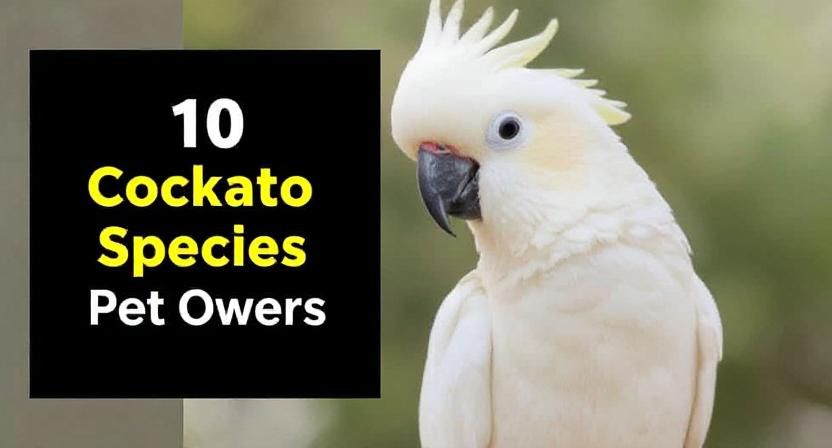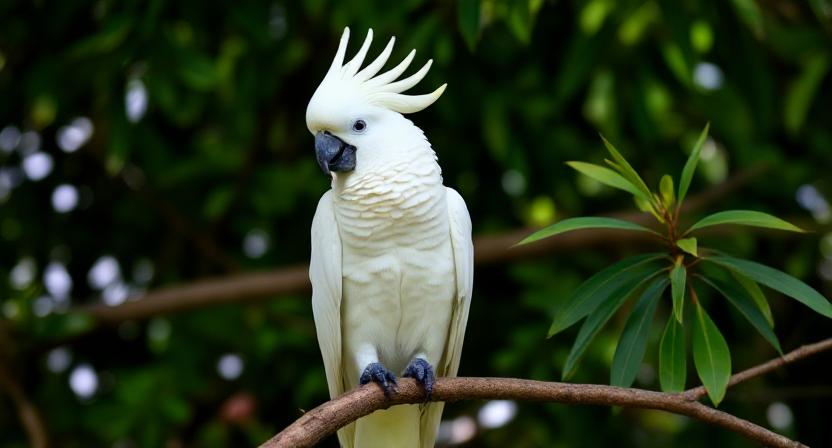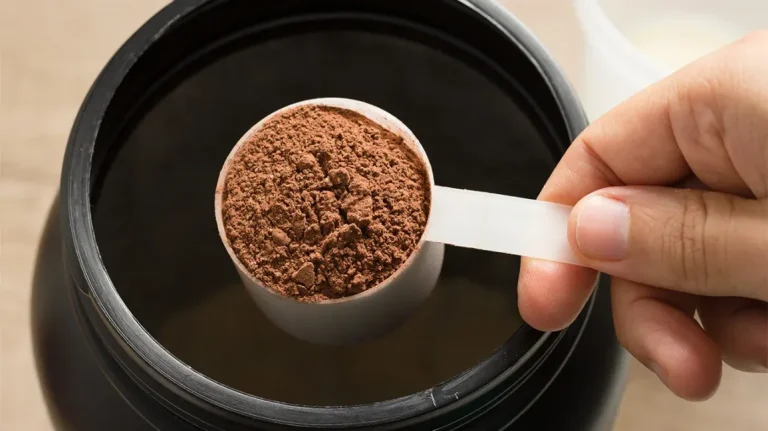
10 Cockatoo Species for Pet Owners
Cockatoos are among the most cherished pet birds due to their intelligence, beauty, and affable nature. With their majestic crests and charming personalities, its stand out not only for their stunning appearance but also for their ability to form deep bonds with their owners. Whether you’re a first-time bird owner or an experienced avian enthusiast, choosing the right it species is crucial for ensuring a harmonious relationship.
Table of Contents
Key Takeaways
- Social and Affectionate: They are highly interactive birds that thrive on bonding with their owners, making them ideal pets for people who can provide plenty of attention.
- Loud Personalities: While charming, most cockatoos are noisy and vocal, so they may not be the best choice for noise-sensitive environments.
- High Intelligence: It is incredibly smart and require mental stimulation through toys, puzzles, and social interaction to prevent boredom.
- Long Lifespan: These birds live for many decades (often 40-80 years), so adopting is a long-term commitment.
- Variety of Species: There are many cockatoo species, each with unique characteristics, so pet owners should choose one that fits their living situation, activity level, and noise tolerance.

10 best cockatoo species for pet owners, examining their unique qualities, personalities, and care requirements to help you make an informed decision.
- Umbrella Cockatoo (Cacatua alba)
- Moluccan Cockatoo (Cacatua moluccensis)
- Lesser Sulphur-Crested Cockatoo (Cacatua sulphurea parvula)
- Major Mitchell’s Cockatoo (Lophochroa leadbeateri)
- Goffin’s Cockatoo (Cacatua goffiniana)
- Cockatoo Species for Small Spaces: The Ducorps Cockatoo (Cacatua ducorpsii)
- Citron-Crested Cockatoo (Cacatua sulphurea citrinocristata)
- Red-Vented Cockatoo (Cacatua haematuropygia)
- The Palm Cockatoo (Probosciger aterrimus)
- Galah Cockatoo (Eolophus roseicapillus)
1. Umbrella Cockatoo (Cacatua alba)
Overview
It is one of the most popular species among bird enthusiasts. Native to Indonesia, this species is known for its distinctive white plumage and bright yellow crest that opens like an umbrella when the bird is excited or alert. As one of the larger it, these birds have an elegant and striking appearance, which is complemented by their playful and affectionate personalities
Personality and Traits
Umbrella Cockatoos are affectionate, loving, and highly social. They are often referred to as “velcro birds” because they bond strongly with their human companions and want to be involved in everything you do. These birds love attention and will actively seek it out. Whether it’s cuddling on your shoulder or engaging in interactive play, its want to be with their people.
Although they are friendly and sweet, they also have a mischievous streak. They can become quite vocal when they want attention and may cause trouble if they feel neglected or bored. Being highly intelligent, they need constant stimulation, both mental and physical.
Care Requirements
It require a lot of attention from their owners. A large, spacious cage is a must, and they should be allowed plenty of time outside the cage each day for exercise and bonding. They thrive in environments where they can be the center of attention, and they do best in homes where their owners are home frequently.
They also require a variety of toys, puzzles, and foraging activities to keep their minds active. If they are left alone for extended periods, they may develop destructive behaviors or become depressed.
Lifespan
Umbrella Cockatoos are long-lived birds, typically reaching 40-70 years in captivity, so they are a lifelong commitment for any potential pet owner.
2. Moluccan Cockatoo (Cacatua moluccensis)
Overview
It is a large, striking bird that hails from the tropical rainforests of Indonesia. With their vibrant salmon-colored feathers on the crest, cheeks, and underparts, Moluccans are incredibly eye-catching. Known for their dramatic displays, they can be both playful and demanding.
Personality and Traits
There are extremely affectionate and often form deep bonds with their owners. These birds crave attention and can become quite destructive if they do not receive enough social interaction. They are known for their loud calls, which can sometimes be overwhelming. Moluccans, however, may become wonderful companions if given the right care and training.
Care Needs
These birds are large and require ample space to fly and exercise. Regular out-of-cage time and a roomy cage are crucial.They also need plenty of mental stimulation, such as foraging toys, to prevent boredom. They can be quite loud, so they are best suited to homes where noise is not a concern.
Lifespan
Moluccans can live for around 60 to 80 years in captivity, so they are a long-term commitment that requires a lot of dedication.
3. Lesser Sulphur-Crested Cockatoo (Cacatua sulphurea parvula)
Overview
It is a smaller species within its family, but don’t let their size fool you—they have plenty of personality. With their striking white feathers and yellow crest, these birds are just as charming as their larger counterparts. Originating from the Philippines, these birds are not only beautiful but also very affectionate.
Personality and Traits
Lesser Sulphur-Crested Cockatoos are known for being social, intelligent, and affectionate. They do best in settings where there is a lot of human connection. It is slightly quieter than other species but still love to communicate and will mimic sounds and words if properly trained.
Care Needs
While they are smaller, they still require a lot of attention and mental stimulation. Lesser Sulphur-Crested Cockatoos are prone to boredom, so it’s essential to provide them with a variety of toys and social interaction. They enjoy being the center of attention and will seek companionship throughout the day.
Lifespan
Given their 40–60 year lifespan, prospective owners should expect a lengthy commitment.
4. Major Mitchell’s Cockatoo (Lophochroa leadbeateri)
Overview
Their soft pink and white plumage, combined with their elegant crest, makes them a favorite among bird enthusiasts. They are native to central Australia and are often praised for their beauty and intelligence.
Personality and Traits
These cockatoos are renowned for being serene and kind. They are not as loud as some of the other species, making them a good option for those who are sensitive to noise. They are also highly social and thrive in environments where they receive plenty of interaction. Major Mitchell’s Cockatoos are affectionate and enjoy spending time with their human companions.
Care Needs
As with all its, Major Mitchell’s require a lot of mental stimulation and physical activity. They do well with consistent training and positive reinforcement.
Lifespan
Major Mitchell’s cockatoos are long term commitment because they usually live 40 to 60 years.
5. Goffin’s Cockatoo (Cacatua goffiniana)
Overview
It is a small but highly intelligent bird native to Indonesia. Their white plumage and small size make them ideal for people with limited space who still want a playful and engaging it. They are highly curious, energetic, and often get into mischief, making them fun but sometimes challenging pets.
Personality and Traits
Goffin’s Cockatoos are one of the most intelligent species of it, capable of learning tricks and even solving puzzles. They are playful, social, and affectionate but can also be independent at times. Due to their high intelligence, they require a lot of mental stimulation to avoid boredom and destructive behavior.
Care Needs
It need a variety of toys, climbing structures, and puzzles to keep their minds occupied. Regular social interaction is crucial, as they can become lonely or anxious if left alone for too long. They are also relatively quiet compared to other it, making them a good choice for people living in apartments.
Lifespan
These birds can live anywhere from 40 to 60 years, which is typical for many cockatoos.
6. Cockatoo Species for Small Spaces: The Ducorps Cockatoo (Cacatua ducorpsii)
It is an ideal choice for bird owners with limited space. Known for its smaller size and charming nature, this species is a great companion in homes with confined areas.
Physical Appearance
It is a relatively small species, measuring around 12 to 14 inches in length. It has soft white plumage with a subtle pink flush on the cheeks and underparts. Its crest is a delicate yellowish-white, which adds to its graceful look.
Personality
It is known for its playful and affectionate personality. It is gentle and enjoys human interaction, making it an excellent pet for families or individuals who can provide regular attention. Although smaller in size, it still requires mental stimulation and social interaction to prevent boredom.
Care Requirements
Due to its smaller size, the Ducorps it requires less space than larger species, making it a good fit for apartments or homes with limited room. However, it still needs a spacious cage, daily out-of-cage time, and interaction to stay happy. A balanced diet, including fresh fruits, vegetables, and high-quality pellets, is essential for its well-being.
Suitability for Small Spaces
It is an excellent choice for those living in smaller spaces. It adapts well to indoor environments and doesn’t require as much room to fly as larger cockatoo species. However, it’s still important to provide it with toys and activities to keep it entertained and stimulated.
Lifespan
The Ducorps Cockatoo (Cacatua ducorpsii) typically has a lifespan of 40 to 60 years.
7. Citron-Crested Cockatoo (Cacatua sulphurea citrinocristata)
Known for its beautiful yellow crest, this medium-sized it is an affectionate and playful species.
Physical Appearance
The Citron-Crested Cockatoo has white plumage with a vibrant yellow crest that distinguishes it from other it. Its crest feathers are particularly bright and give it a distinctive look.
Personality
These birds are highly social and enjoy interaction with their owners. These birds are highly social and enjoy interaction with their owners.
Care and Suitability
Citron-Crested Cockatoos thrive with proper care, including a varied diet, mental stimulation, and daily social interaction. They are best suited for experienced bird owners, as they need ample space and attention to stay happy and healthy.
Lifespan
The Citron-Crested Cockatoo typically has a lifespan of 40 to 60 years.
8. Red-Vented Cockatoo (Cacatua haematuropygia)
It is a captivating bird native to the Philippines. With its vibrant red tail feathers and white body, this medium-sized it stands out as one of the more visually striking species in itsfamily.
Physical Appearance
Its features a white body with a distinctive red vent (tail feathers), which makes it easily identifiable. It has a slight yellowish hue around the face, adding to its charm. The overall plumage is soft and well-defined, making it a beautiful bird to admire.
Personality
It is known for its affectionate, social, and playful temperament. It enjoys being the center of attention and forms strong bonds with its human companions. While not as loud as larger it, it still requires regular interaction and mental stimulation to remain happy.
Care and Suitability
This species needs ample space to roam and engage with its environment. Due to its sociable nature, the Red-Vented Cockatoo thrives in homes where it can receive plenty of attention.
Lifespan
The Red-Vented Cockatoo typically has a lifespan of 40 to 60 years in captivity.
9. The Palm Cockatoo (Probosciger aterrimus)
It also known as the Giant Black it, is a striking and impressive bird native to the rainforests of northern Australia, New Guinea, and surrounding islands. With its dramatic appearance and unique behaviors, it is a favorite among experienced bird enthusiasts.
Physical Appearance
It has dark, almost charcoal-gray to black plumage, and its most distinctive feature is the prominent red cheek patches that become visible when the bird is excited or agitated. The bird’s large, powerful beak and the dramatic crest on its head add to its commanding presence.
Personality
This species is highly intelligent and independent, known for its more reserved and solitary nature compared to other it. While it can form strong bonds with its human companions, it is not as overtly affectionate as other species. It enjoys interactive play and can display unique behaviors, such as “drumming” on objects with its beak, which is thought to be a form of communication or self-expression.
Care and Suitability
Due to its size, intelligence, and need for stimulation, it requires a large living space and consistent mental and physical engagement. It thrives in an environment that offers various toys, puzzles, and opportunities for out-of-cage time. Owners should be experienced and prepared for its demanding needs, including daily interaction, socialization, and attention. This species is not ideal for first-time bird owners due to its complex care requirements and somewhat reserved personality.
Lifespan
It has an impressive lifespan, typically ranging from 40 to 60 years.

10. Galah Cockatoo (Eolophus roseicapillus)
Its also known as the Rose-Breasted, it is a striking and popular species native to Australia. Recognizable by its beautiful pink and Gray plumage, the Galah is a beloved pet due to its friendly nature and moderate size.
Physical Appearance
The Galah is a medium-sized cockatoo, measuring about 14 to 16 inches in length. Its most distinguishing feature is its soft, pink face, chest, and crest, which contrast with the pale gray wings and back. The bird’s vibrant coloration makes it stand out among other adding to its appeal as a pet.
Personality
Galahs are known for their affectionate, playful, and social nature. They thrive on attention and form strong bonds with their owners. These birds are intelligent and can learn tricks or even mimic speech, although they are not as vocal as some other it. Galahs are generally gentle, making them great companions for families, and they enjoy spending time interacting with humans and other pets.
Care and Suitability
As an active bird, the Galah requires daily interaction and mental stimulation to remain happy and healthy. A varied diet of fresh fruits, vegetables, high-quality pellets, and seeds is essential for its well-being. Galahs are also known to be less demanding in terms of noise compared to larger its, but they still need enough space to move around and play. They are best suited for owners who can dedicate time to bonding and providing mental enrichment.
Lifespan
The Galah Cockatoo (Eolophus roseicapillus) has a lifespan of 40 to 60 years.
Conclusion
The 10 best cockatoo species for pet owners offer a wide range of personalities, sizes, and care requirements, making them suitable for different types of bird enthusiasts. Whether you’re drawn to the playful Galah or the majestic Moluccan, each species brings unique traits to the table, from intelligence and affection to long lifespans and vocalizations. However, owning it requires a significant commitment of time, space, and attention. These birds are incredibly social, intelligent, and affectionate, making them rewarding companions for those who can meet their high care demands.
FAQ
1. Which cockatoo species is best for beginners?
It is a great option for first-time bird owners due to its friendly and playful nature. It’s smaller in size and generally easier to manage compared to larger its like the Moluccan.
2. Are cockatoos noisy?
Indeed, it have a reputation for making loud noises, particularly when they are lonely or trying to get attention. Larger species, like the Moluccan or Sulphur-Crested Cockatoo, are particularly known for their loud calls. However, their social nature makes them want to vocalize and interact regularly.
3. How long do cockatoos live?
Cockatoos have long lifespans, typically ranging from 40 to 70 years, depending on the species. For instance, the Palm Cockatoo can live up to 60 years with proper care.
4. Do cockatoos need a lot of attention?
Yes, cockatoos are highly social and thrive on daily interaction. They can become bored or stressed if left alone for too long, which may lead to behavioral issues.
5. Can cockatoos be kept with other pets?
While cockatoos are social birds, they may not always get along with other pets. Introducing them to other animals should be done cautiously, and they typically do best when given undivided attention from their owners.




Nice Article